Travel Guide To Hanoi Vietnam [Things To Do and More]
Hanoi is one of the main gateways to Vietnam. Every year, many tourists choose Vietnam's capital as a part of their Southeast Asia visiting journey. Find out the best time to visit, top tourist attractions and things to do with our Hanoi Travel Guide.
If you are planning a trip to Vietnam and choose Hanoi as your gateway, you could learn more about the beautiful Vietnam and its other parts; and immediately obtain yourself this helpful Vietnam Travel Guide
Introduction to Hanoi Vietnam
Located by the banks of the Red River in northern part of the country, Hanoi - Vietnam’s capital city, is the second largest city in Vietnam by population (only after Ho Chi Minh City). Hanoi remained the main capital of Vietnam until 1802 when the last dynasty of Vietnam, the Nguyen, moved to Hue. Then it has been served as the capital of the French Indochina from 1902 to 1954 before becoming the capital of an independently reunified Vietnam after proudly victory in the North Vietnam War. That is the reason why the city is a harmony between French colonial architecture and modern liveliness of Southeast Asia. You can meet the vestiges of French colonial influence everywhere, particularly in the Old Quarter, home to thousands of colonial-era buildings. Wandering along its tree-lined boulevards or watching busy daily life of people here from a street coffee shop, you’ll see the charm of this city. Hanoi celebrated its millennial anniversary in 2010 though it is said to be much older, having been inhabited since at least 3,000 BC.
Currently, Hanoi with young and savvy population is the economic central of the Red River Delta economy with strong and fast development of industries, finance, commerce and services. Many foreign visitors would love to add this dynamic and pretty city into their favorite destinations to experience the blend of East and West as well as the rich traditional culture. Whether you have set foot here one or many times, this enchanting land with friendly, hospitable people will always welcome you. Following this Hanoi Vietnam Travel Guide to make your every single moment travelling to Hanoi worth it!
Best time to visit Hanoi
Hanoi has four seasons with a typical tropical climate. The winter drops in December and the hottest summer days are from July to August. It is quite difficult to give an exact prediction of Hanoi weather in each month, or even each season, as temperatures, rainfall and sunshine can change from days to days without any prior notice.
However, the best time to visit Hanoi is during spring and autumn. In spring (from February to the beginning of April), the weather is pleasant with average temperature of 15-20°C and a clear sky. Moreover, the most important celebration of Vietnam, the traditional Vietnam Tet holiday (Lunar New Year), may fall in the end of January or the first half of February, when many tourist attractions and shops are temporarily closed during that time, and you should be ready for that situation if you are planning to visit Vietnam during that time. In autumn (from August to October), the weather is mild with temperature ranging around 25°C, emerald sky and cool air will be perfect to walk along the tree-lined boulevards, capture beautiful bloomed flowers fields or explore the Old Quarters.
Things to do in Hanoi - Places to visit in Hanoi
1. Visit Ho Chi Minh Mausoleum
Located in Ba Dinh Square, Ho Chi Minh Mausoleum is one of the most prominent attractions that tourists should not miss when visiting Hanoi. The construction was officially started on September 2, 1973 and completed on August 19, 1975. This is the place preserving the glass coffin, which holds the body of President Ho Chi Minh, the first president of the Democratic Republic of Vietnam and one of the most famous iconic leaders in the world.
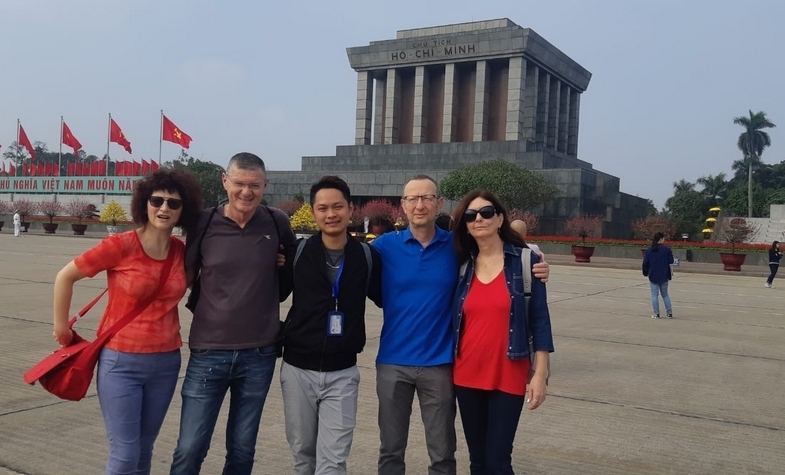
Tourists' photo in front of Ho Chi Minh Mausoleum - Tour organized by Travel Authentic Asia
Normally, visitors visit the complex in the order: Uncle Ho's Mausoleum to the Stilt House, Uncle Ho's fish pond, then visit Ho Chi Minh Museum and finally the extremely unique architecture One Pillar Pagoda. Once arriving here, you can easily follow the instructions of the mausoleum management or the flow of people queuing to visit the site. The trip to Uncle Ho’s final resting place can be an extraordinary experience as it is not just a tourist attraction; it remains the eternal memories about a unique respected leader in Vietnam history
2. Visit One Pillar Pagoda
One Pillar Pagoda or Mat Pagoda, also known as Dien Huu Tu, is a pagoda located in the heart of Hanoi capital with a unique architecture in the lotus shape on a single pillar. Built in 1049 by Emperor Ly Thai Tong, the pagoda has been preserved and undergone many major renovations, including the important restoration in 1954 after being exploded by the French colonial.
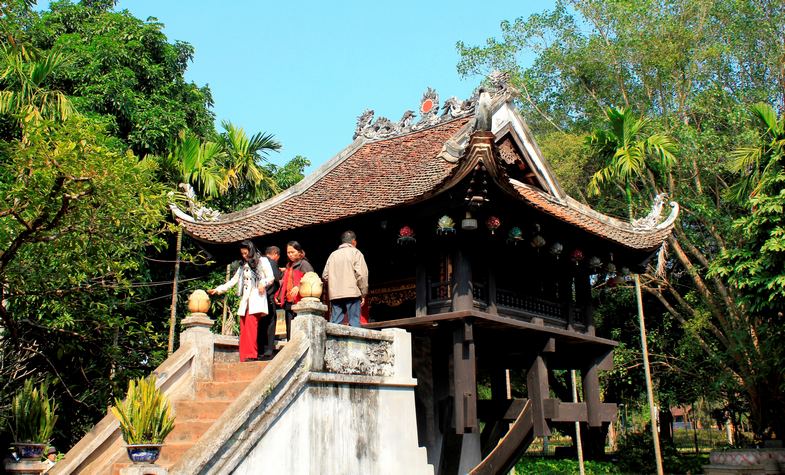
Visiting Hanoi One Pillar Pagoda
One Pillar Pagoda is not only a creative architectural work but also a spiritual destination, a thousand-year cultural symbol of Hanoi. It has been recognized as "The most unique architectural pagoda" by the Asian Record Organization. Visiting the pagoda, you could feel the tranquil atmosphere while praying for fertility and good health for your family and yourself.
3. Temple of Literature tour
The Temple of Literature, also known as “Van Mieu”, is Vietnam’s first university and is in the thing-to-do-in-Hanoi list of visitors during their Hanoi tour. Originally built in 1070 dedicated to Confucius, scholars and sages, the building is extremely well preserved and is a symbol of Confucius’ deep cultural influence in Vietnam. This cultural complex includes a lake of literature, the Well of Heavenly Clarity, turtle steles, pavilions, courtyards and passageways that have been used by royalty. Visiting the Temple of Literature, you can discover ancient buildings from the Ly and Tran dynasties in the tranquil atmosphere and get more knowledge about Vietnamese history.
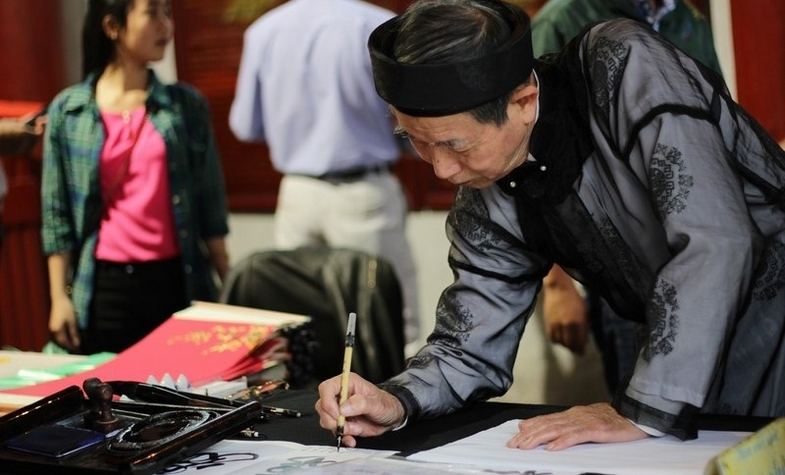
Calligraphy Master at Hanoi Temple of Literature
4. Visit Hanoi Old Quarter
Besides the French Quarter (in Ba Dinh District) where the important government offices are located, Hanoi Old Quarter (in Hoan Kiem District) is considered the city’s center and the main tourist attraction. Also known as the 36 streets, the Old Quarter has been a business hub for more than 500 years. The word “Hang” in the start of the street name describe the produce that are sold there for example Hang Bac – Silver street, Hang Gai – Silk street, Hang Buom – Sail street…It is worth spending a few hours wandering or taking the cyclo ride through the Old Quarter to try Vietnamese food, grab some beer (Bia hoi), do shopping and know about daily life of the locals. The most common sight of the streets in Hanoi is the pack of cars, motorbikes, bikes around pedestrians and the Old Quarter is not an exception. Strolling here is much more different from a leisurely walk in the park but it is surely an interesting experience when visitors can join the traffic in local style.
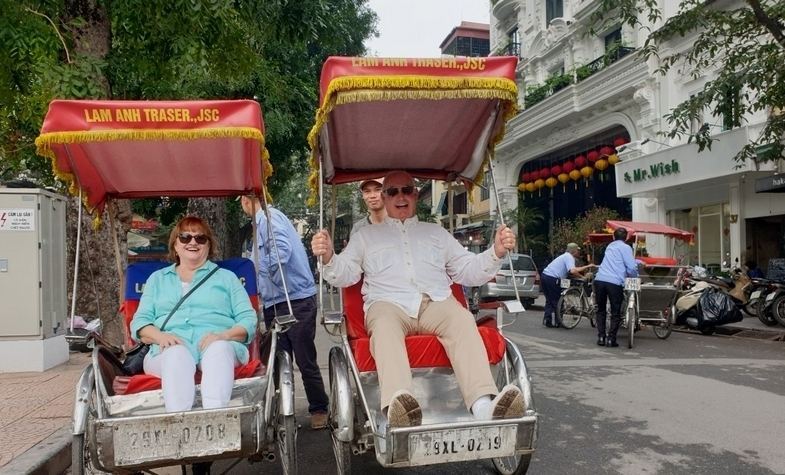
Cyclo tour around Hanoi Old Quarter
5. Hoan Kiem Lake and Ngoc Son Temple tour
Standing at the heart of Hanoi, Hoan Kiem Lake attracts tourists who are looking to get away from the hustle and bustle of the city. Lying on a small island in the middle of the lake is the Turtle Pagoda, also known as “Thap Rua”, dedicated to the legendary gigantic turtle living here. Coming to this area in the early morning, you will see locals doing morning exercises, practicing Taiichi, running, walking or cycling around the lake.
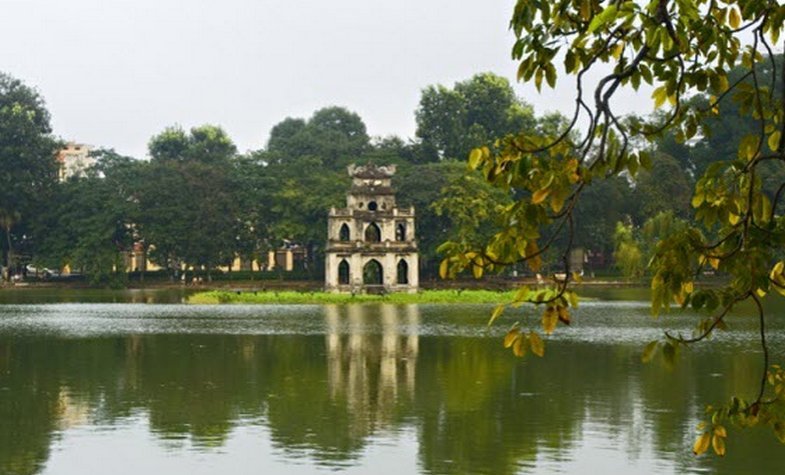
Hoan Kiem lake, the heart of Hanoi, Vietnam
Ngoc Son temple was built to commemorate the 13th century military leader Tran Hung Dao who was famous for his bravery in the battle against the Yuan Dynasty. The island on which the temple is built is known as Jade Island and can be easily accessed via the red wooden bridge named “Cau The Huc” or Rising Sun Bridge. The temple is also protected by two towering posts decorated with Chinese writing. Additionally, the temple preserves a large bronze bust, some ancient artifacts including ceramics and a preserved specimen of a giant turtle found in the lake weighing 250 kilograms. The lake and temple are probably the most ideal places in Hanoi to visit and enjoy the peaceful view.
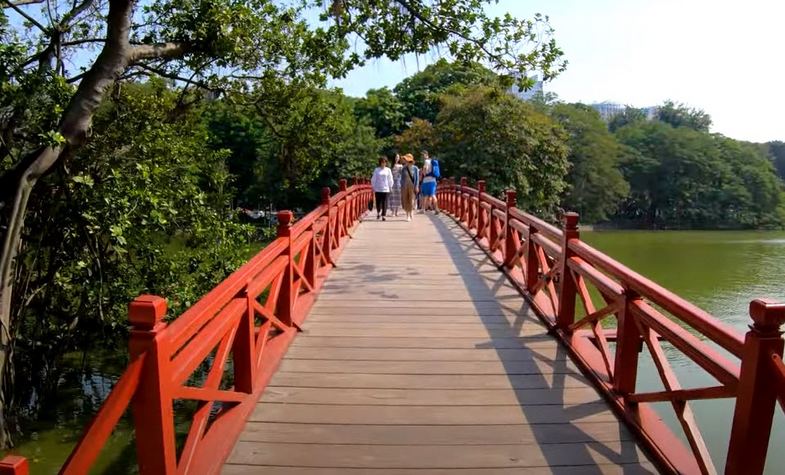
The Huc Bridge leading to Ngoc Son Temple
6. Water Puppet Theatre
Water Puppetry is a lively Vietnamese storytelling that dates back to the 11th century. Puppets are carved from wood and the shows take place in a waist-deep pool to revive the scene when villagers working in flooded rice fields. Performances are accompanied by a Vietnamese orchestra playing various traditional musical instruments including drums, wooden bells, horns, bamboo flutes and cymbals. There are also authentic Vietnamese operatic songs telling the story that is being acted by the puppets on the stage which makes the show more interesting. Most of the shows recount Vietnamese folk tales of rural life with plenty of good humor and feature the famous Legend of the Restored Sword of King Le which tells the tale of Hoan Kiem Lake and the giant tortoise.
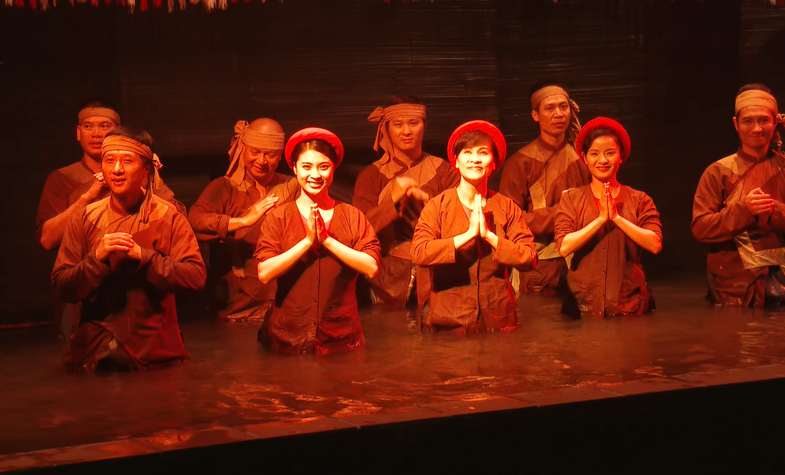
Water puppet artisans, Water puppet show curtain call
7. Hoa Lo Prison
Maison Centrale in Hanoi, also known as Hoa Lo Prison or ‘Hanoi Hilton’ is where many U.S. soldiers were in-jailed. This site housed Vietnamese revolutionaries as well as American POW (including the US Senator John McCain) during the Vietnam war which tells us the less known horror stories happen to our most celebrated nationalist leaders. The total area of the former prison area is more than 12,000m2. However, today only 2,434m2 is preserved to become a relic area, serving the purpose of tourists who want to witness the scenery of the colonial prison and get more knowledge about Vietnam war.
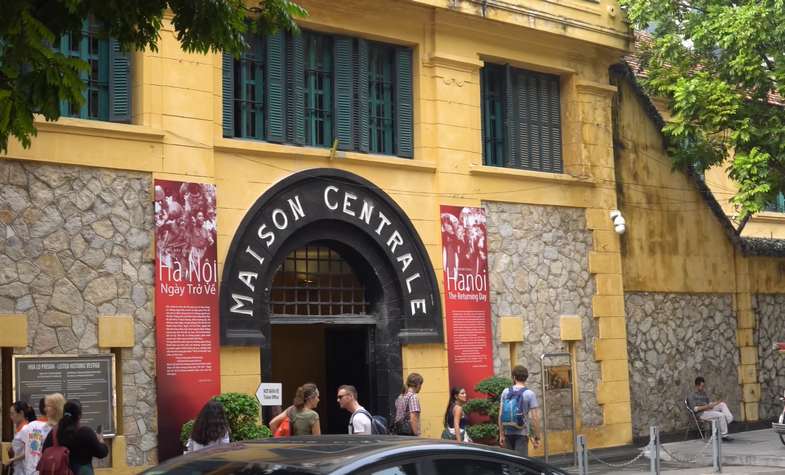
Maison Centrale - Hoa Lo Prison in Hanoi, Vietnam
8. Museum of Ethnology
The Museum of Ethnology offers a great insight into the 54 different ethnic groups living in different areas in Vietnam. It has been established in an effort to preserve cultural heritage and promote socio-cultural diversity within the country. The outdoor display area exhibits a variety of Vietnamese typical homes as full-scale replicas and leisure pursuits including traditional water puppet theatre and calligraphy set within the peaceful gardens. The future important aim of the museum is to also showcase the many cultural practices and civilizations across Southeast Asia. Visitors are welcome to browse some of the vast research on offer at this public museum which is also a center for ethnographic research. Spending time at this place will give you knowledge and much better understanding of Vietnamese history and culture.
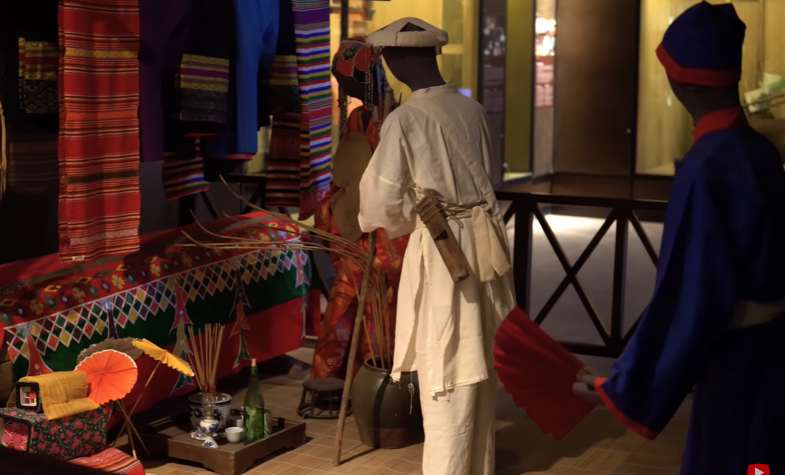
Museum of Ethnology displays the diversity of Vietnamese ethnic culture
9. West Lake
Located about 10-15 minutes driving from Hoan Kiem Lake, West Lake - the biggest fresh water lake in Hanoi, is surrounded by lots of green trees and important ancient structures. Here you can cycle around the lake to enjoy the fresh air, have a fancy meal on board while appreciating beautiful lake view, visit Tran Quoc Pagoda or Quan Thanh Temple, grab some local specialties such as crispy shrimp cake and vermicelli and shellfish soup (bun oc) …
10. Imperial Citadel of Thang Long
The Imperial Citadel of Thang Long, an intriguing relic of Vietnam’s history, was recognized a UNESCO World Heritage Site in 2010. Also known as the Hanoi Citadel, the area displays many artifacts and items dating back to between the 6th and 20th centuries which were excavated in 2004. Coming to this site, visitors should head for the display room that features interesting excavated items and explore the grounds with archeological objects along the road.
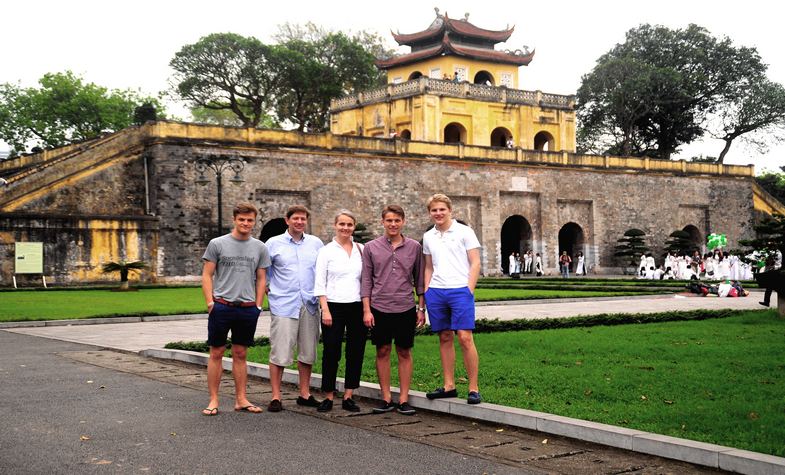
Visit Imperial Citadel of Thang Long - Tour organized by Travel Authentic Asia
What to eat in Hanoi - Specialties of Hanoi - Hanoi street food
1. Pho Hanoi
Originated in Hanoi, Pho is arguably the national dish of Vietnam and is the quintessential must-try dish when traveling to Vietnam. Pho has three main components: broth, rice noodles, and meat (usually beef or chicken). In some places, it is also accompanied by a plate of fresh herbs. You can easily find lots of local restaurants selling Pho at any time in a day. Maybe you have tried Pho a few times before visiting Vietnam, but you will discover the reasons why Hanoi Pho in the capital beats Pho in anywhere else.
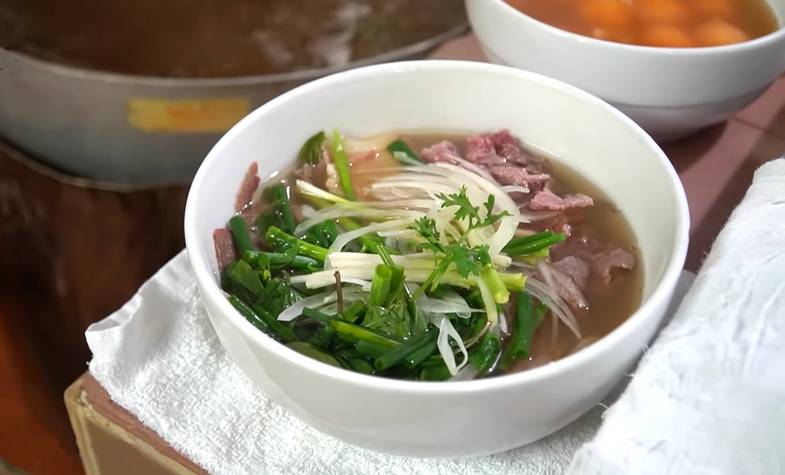
Savory Pho Hanoi
2. Bun Cha (Barbecued Pork with Rice Vermicelli)
If Pho is Hanoi’s number one famous dish, the next one must be Bun Cha as it quickly comes to being tourists’ favorite food not be missed. The dish consists of grilled pork, rice noodles, a plate of fresh herbs, and a bowl of dipping sauce with sliced papaya, red chili and garlic. If these ingredients aren’t enough for you, then add fried spring rolls called Nem to make it more fulfilled.
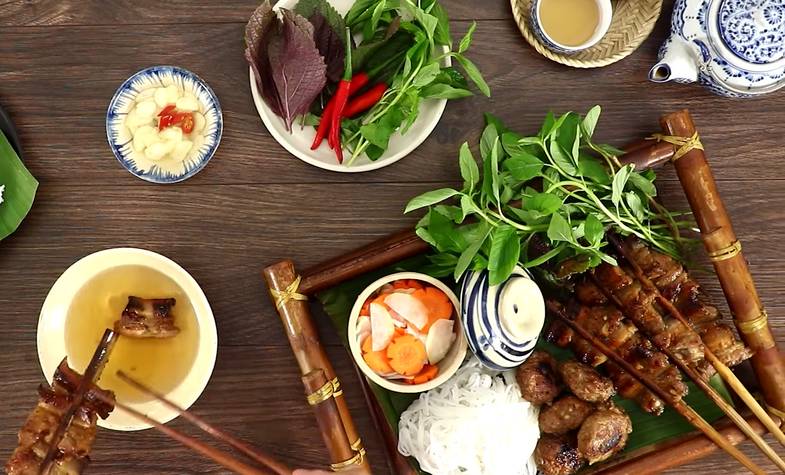
Tasty Bun Cha Hanoi
3. Cha Ca (Turmeric Fish with Dill)
Cha Ca, a distinctive Hanoi delicacy, is definitely a must eat in Hanoi. The special ingredient in Cha Ca is grilled fish, typically mudfish or snake-head fish, with garlic, ginger, turmeric, and dill served on sizzling pan. This dish is made right on the table and the experience of preparing the dish is almost as much fun and interesting as eating it.
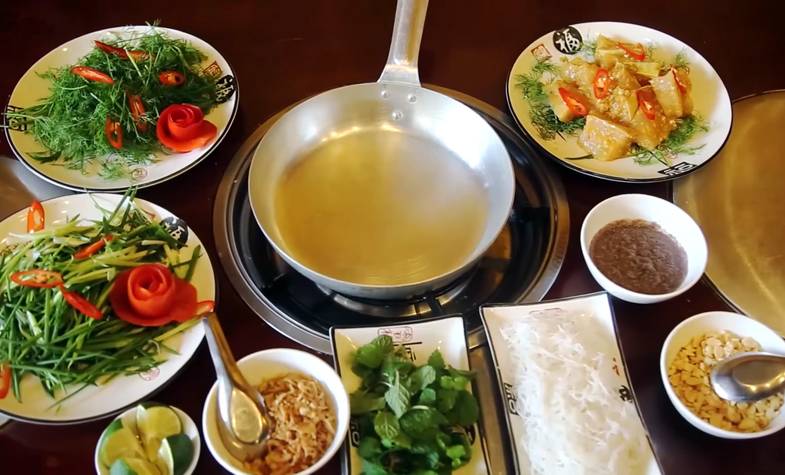
Cha ca La Vong, Hanoi Vietnam
4. Bun Thang (Rice Vermicelli with Chicken, Egg, Pork)
Bun thang or rice vermicelli with chicken, egg and pork is subtle and delicious cuisine that you can be enjoy at any time of the day. The flavorful and special broth made from 20 ingredients, including dried shrimp, squid, shrimp paste, spring onion, coriander, ginger, mushroom, beet, fish sauce, sugar candy, and vinegar still brings the elegance feeling of the Hanoi cuisine. It is also a particularly attractive Hanoi dish as the noodles, chicken, eggs, pork slices, and a dollop of shrimp paste are carefully decorated to resemble a flower.
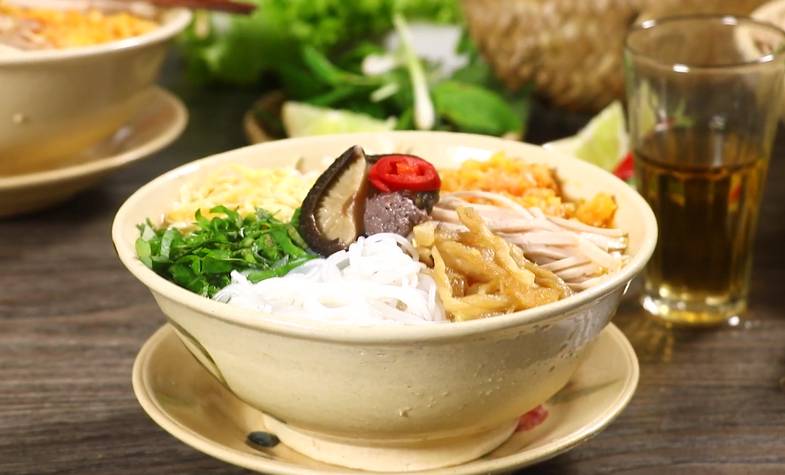
Bun thang - the subtlest dish origined in Hanoi
5. Banh cuon (Rolled rice paper with pork)
Great as a light breakfast or midday snack, “Banh cuon” is another local must-try specialty from Northern Vietnam. Banh cuon is made of a thin rice paper rolled and filled with ground pork meat and minced wood ear mushrooms which is served with fried shallots and cilantro herbs on top.
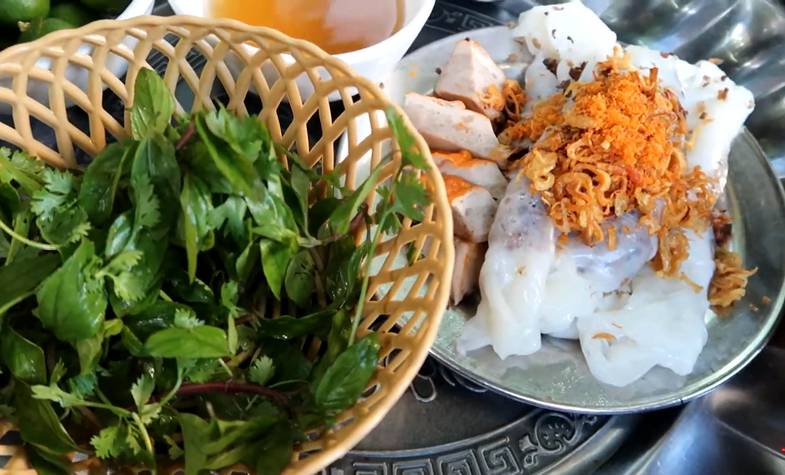
Banh cuon Hanoi
6. Banh goi (Fried Dumplings)
Shaped like miniature pillows, “Banh goi” contains finely-chopped glass noodles, wood ear mushrooms, minced pork and steamed egg within a rice-flour pastry. It is then deep-fried for a crispy texture and served with a sweet-sour dipping sauce made of garlic, chili, sugar, lime juice, and fish sauce. You can also eat Banh Goi with fresh lettuce and other herbs to make it more delicious.
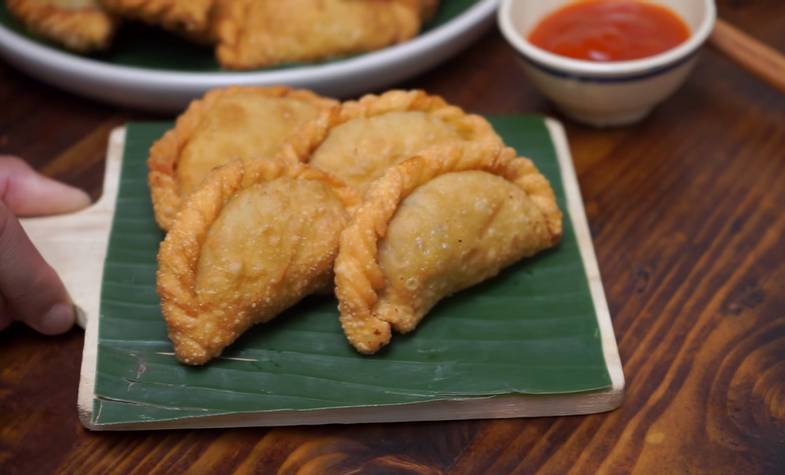
Vietnamese Fried Dumpling
7. Nem cua be
Nem cua be, or crab spring rolls, is a popular Vietnamese street food made from sea crab and vermicelli noodles. The crab spring roll will be cut into small pieces before serving on the plate. They are eaten as an appetizer while waiting for the main dish of Bun cha or dipped into the savory bun cha soup. Eat like the locals do - having Nem Cua Be with fresh herbs and lettuce, as well as dipping it in “nuoc cham” - sauce.
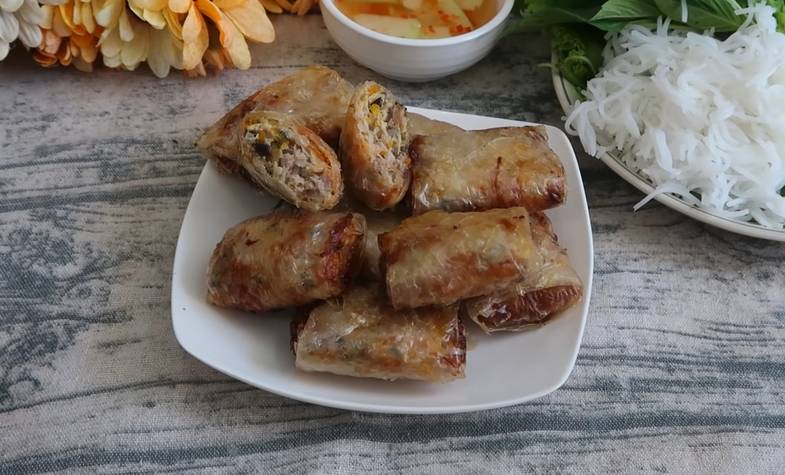
Crispy Nem Cua Be
8. Banh mi (Vietnamese Sandwich)
The Vietnamese Banh mi have made it distinctively their own. It is a normal baguette stuffed with various ingredients including pork, pâté, cured ham, Vietnamese herbs and vegetables like coriander, cucumber, carrot, slices, radish and more are different, depending on what part of the country you are in. Eating this unique local food, you will savor spicy, salty, savory, sweet, and aromatic tastes in each bite.
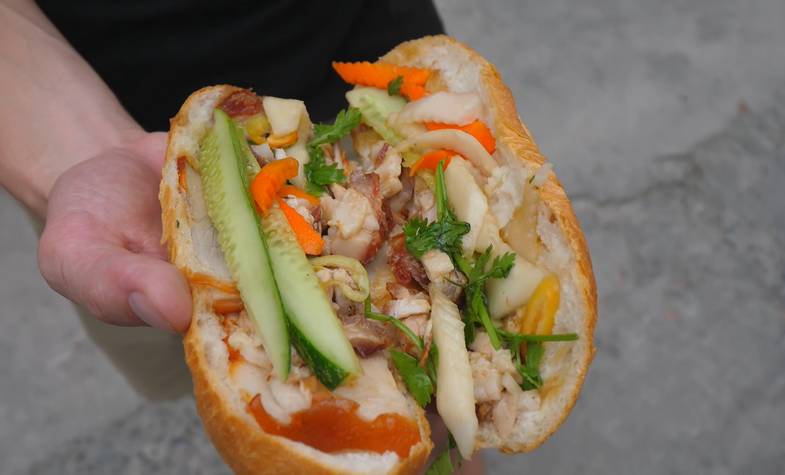
Vietnamese World famous Banh Mi
9. Ca phe trung (Vietnamese Egg Coffee)

Vietnamese origined Egg Coffee
Egg coffee or “Ca phe trung”, the most famous coffee in the North of Vietnam, is a thick dark coffee topped by egg yolk whipped with condensed milk into an airy froth. Rich in taste, it can remind you of tiramisu dessert, but still own its unique taste and feeling.
***
Travel Authentic Asia Company is your best choice for discovering the beauty of Southeast Asia. Our experienced and knowledgeable travel advisors are committed to helping you create a tailor-made tour and extraordinary experiences in this majestic region.
If you're looking for an authentic cultural experience, do not hesitate to contact Travel Authentic Asia to choose a Vietnam tour, Southeast Asia tour package or to customize your own style tour to South East Asia.

